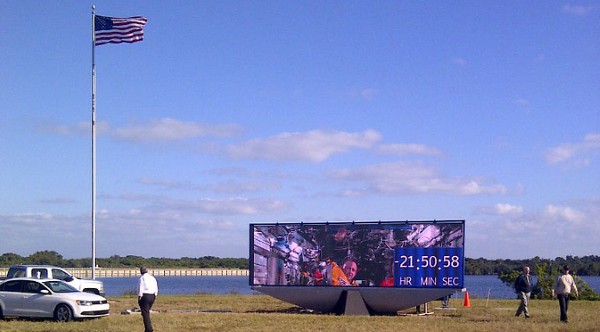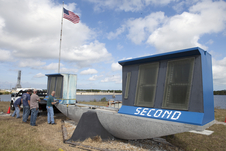The new generation of human space exploration spacecraft is getting a new generation clock to count it down for launch on December 4.
The new forms of both the spacecraft and clock and clock will look familiar, but carry substantial changes and are run by modern technology. In the same way that NASA's Orion is a capsule shape akin to Apollo, the new countdown display at Kennedy Space Center's Press Site doesn't look all that different from its predecessor. And again, just as in the case of Orion and Apollo, the new version of the countdown display is far more capable and boasts technology more akin to a stadium television than a simple wristwatch.
 |
A New LED display has been contrusted to replace former amalog countdown clock at the Press Site at NASA's Kennedy Space Center in Florida. New display allows TV images to be shown along with numbers. (NASA)
|
The new display, which sits on the same mount as the former countdown clock, is already up and running and has been showing NASA TV images along with a test countdown in the lower corner. The completion of the display came about a week before Orion heads to space on its first flight test. News media, families of center employees and NASA guests will do as so many have done before: follow the progress of the countdown on the grassy area around the turn basin while looking out toward the launch pad for the rocket to ignite.
This time though, they will be able to get far more from the display than the clicking lights and numbers. NASA's whole prelaunch program will be available to showcase on the display. So if the numbers stop counting down, those following along won't have to wonder whether it is a built-in hold or a technical glitch with the rocket – they'll know quickly from the screen.
"I think this is an upgrade that will really surprise news media with how much more information they will get to see while they are outside to watch the launch," said George Diller, a NASA Public Affairs officer whose launch commentary has accompanied dozens of countdowns for space shuttles and expendable rockets. "It's really neat to be able to see the launch pad up close on the monitor while still experiencing the magic of seeing the countdown and then the rocket rise above the tree line."
The new display is very similar in size to the historic clock, with a screen nearly 26 feet wide by 7 feet high. While not true high-definition, the video resolution will be 1280 x 360.The new countdown clock sports a widescreen capability utilizing the latest breakthroughs in outdoor LED display technology. The display, which comes at a cost of $280,000, will provide images from multiple sources, as well as the countdown launch time. Also, streaming video will be an option.
"Visually it will be much brighter and support whatever mission it is called upon," said Timothy M. Wright of IMCS Timing, Countdown and Photo Services at Kennedy. "Hopefully the new display will be accepted like its predecessor."
 |
The analog timer has been removed to make room for new display. (NASA)
|
The pressure to improve the display was high for many reasons, technical as well as nostalgia. The former countdown clock earned its place in space lore as an icon familiar to everyone who watched an Apollo or shuttle launch on TV. Media members and visitors took thousands of pictures of themselves in front of the clock as proof of their pilgrimage to the Florida spaceport. The clock was even the centerpiece of several Hollywood scenes, the 4-foot-high, 2-foot-wide numbers helping add tension for the audience as a launch drew near.
"It is so absolutely unique -- the one and only -- built for the world to watch the countdown and launch," Wright said. "From a historical aspect, it has been very faithful to serve its mission requirements."
The new display is expected to become just as ingrained in the public's awareness as Orion progresses from uncrewed flight tests to deep space missions taking astronauts past the moon. The display will also chronicle launch days for the private companies working with NASA's Commercial Crew Program to launch astronauts from American soil to the International Space Station in 2017.
Of course, the display also will mark the time before the liftoff of NASA's scientific satellites from Florida, something the former clock watched over as well.
The countdown clock became part of the Kennedy landscape during the Apollo era. It ticked off the progression of launches ranging from moon landings to Skylab crew launches to the historic liftoff of the Apollo-Soyuz mission in 1975 that saw NASA and the Soviet space program connect in space, a presage of the cooperation in full effect now in the form of the International Space Station and its crucial research. All the space shuttle missions and scores of planetary probes and Earth-focused observatories also lifted off in the background of the steadily clicking clock.
While launch days were clear, the clock structure took a beating from the Florida weather on more than one occasion, including sustaining damage from three hurricanes in 2004. In another parallel to the transition into the next space age, the older display could not be sustained and there was not going to be a better time to replace it than when the whole of Kennedy is transforming into a spaceport of modern infrastructure and abilities.
"We've been refurbishing our structures and facilities here for more than three years and I think this new countdown display is symbolic of the way we can meet the demands of the future using modern technology without losing sight of our landmark accomplishments," said Bob Cabana, director of Kennedy Space Center and former shuttle commander.
Even the network that will control the clock has been modernized during the previous three years. The center now uses Global Positioning Satellites to coordinate timing across the center rather than the timing facility that was housed in the Central Instrumentation Facility at Kennedy, a building better known as the CIF.
The clock is controlled from the Launch Control Center by the Timing and Imaging Technical Support Group, also known as the “timing crew.” From their consoles, technicians monitor and distribute the official time to NASA facilities, including the firing rooms.
Before a launch, the launch director performs the traditional call to stations and the countdown clock is activated and begins to count down eventually to T-zero in hours, minutes and seconds. After launch, the clock runs forward, recording mission-elapsed time.
While the new display takes over the watch for launch day, the former clock will be set up again at the Kennedy Space Center Visitor Complex where the public will see it up-close beginning in early 2015.
"Many feel this clock is as much of an icon as Apollo and shuttle," Berrios said. "At the visitor complex, it would ignite the magic surrounding a launch, and begin the countdown to explore Kennedy Space Center as part of the entry experience for the guests of the visitor complex."













